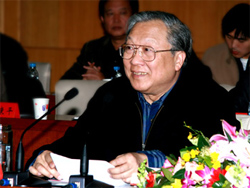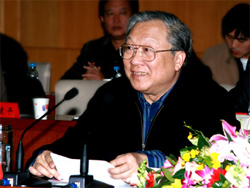

Under the guidance of the scientific outlook on development, CAS has to realize nine transitions in such aspects as research mode, science evaluation, human resource management and research organization, stresses CAS President LU Yongxiang.
CAS has to realize the following nine transitions under the guidance of the scientific outlook on development, stresses CAS President LU Yongxiang. He made the remarks at a symposium held on 21 November in Beijing.
First of all, a change should be made in the research mode, from isolated, free exploration to innovation activities focusing on goal-oriented fundamental and cutting-edge research, key high-tech development, major systems integration, and systematic and basic studies concerning sustainable development. These activities should be performed in light of key S&T issues in the world and the major strategic demands of the country.
Second, a transition should be made in science evaluation, from the conventional practice laying stress only on research papers and awards to new approaches also giving importance to innovative contributions and innovation levels, qualities and development trends. On the basis of peer review, evaluation should be more concerned with the contributions of research work to practice and whether it can withstand the test of time.
Third, a transition should be made from a one-sided emphasis on S&T innovation to an equal stress on both innovation and technology transfer.
Furthermore, in order to optimize personnel structure and upgrade the S&T contingent, a change should be made in human resource management, from paying attention to individual talent recruitment to laying emphasis on the selective introduction and cultivation of professionals according to development requirements.
Fifth, the way that basic research units are organized should be transformed from the traditional ones led by principal investigators to novel ones adaptable to various research activities, ranging from free exploration, large science projects, high-tech frontier research, key technology development, major systems integration and innovation to the long-term systematic buildup of data and their testing, and technology transfer.
Sixth, conversion should be made in organizational management from a system that is mainly composed of research institutes established according to academic disciplines to a new one featuring a matrix grid and composed of both research institutes and innovation clusters formed in light of major strategic objectives of innovation.
Seventh, expectations of scientific research should change from the idea of stressing S&T outputs only to a new concept giving equal importance to human resource development and education reform, plus innovation environment upgrading and management innovation so as to produce first-class research, management, academic environment and personnel.
Eighth, the existing distribution of CAS institutes across the country has to be reshaped according to the needs of national socioeconomic growth and regional development, as well as to native natural resources and environment.
Finally, the financial resources of CAS should be diversified. In addition to stable support from the central government, efforts should be made to explore other sources from various sectors, including local authorities, business enterprises and overseas organizations.








